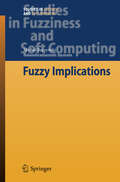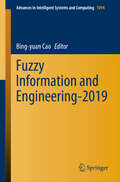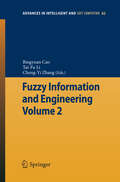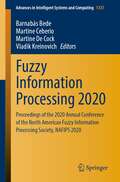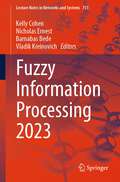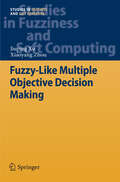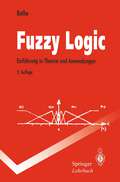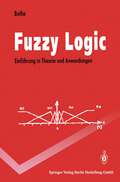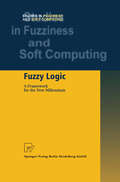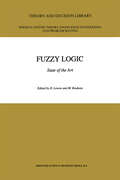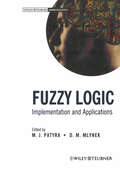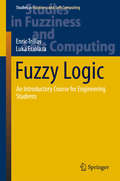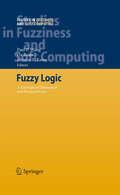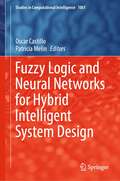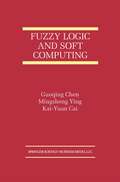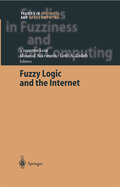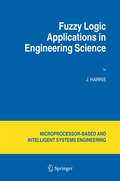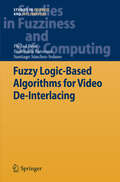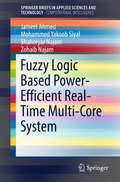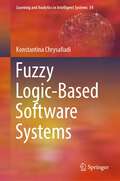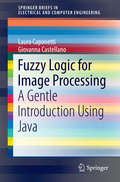- Table View
- List View
Fuzzy Hybrid Computing in Construction Engineering and Management: Theory and Applications
by Professor Aminah Robinson FayekThis book provides an introduction to fuzzy logic and surveys emerging research trends and the application of state-of-the-art fuzzy hybrid computing techniques in the field of construction engineering and management. Authors cover the theory and implementation of fuzzy hybrid computing methodologies for arithmetic, optimization, machine learning, multi-criteria decision-making, simulation, cognitive maps and data modelling. The practical application of these techniques to solve real-world problems across a wide range of construction engineering and management issues is also demonstrated and discussed. The completion of effectively planned, executed and controlled construction projects is dependent on numerous interacting factors and human activities, both of which introduce vagueness and subjective uncertainty into already complex processes. While expert knowledge is an essential component of effective decision-making, analysis and consideration of expert knowledge expressed in linguistic terms remains a challenging aspect of construction engineering and management. Fuzzy logic, which has applications in many disciplines, has the potential to address certain challenges inherent in construction engineering and management, in part because of its strengths in modelling human reasoning, dealing with subjective uncertainty and computing with linguistic terms. However, fuzzy logic alone has a number of limitations that can only be overcome by its integration with other, complementary methodologies, together leading to advanced and powerful fuzzy hybrid computing techniques. This book is of particular interest to students, researchers and practitioners who want to learn about the latest developments in fuzzy hybrid computing in construction engineering and management.
Fuzzy Implications (Studies in Fuzziness and Soft Computing)
by Michał Baczyński Balasubramaniam JayaramFuzzy Information and Engineering: Proceedings of the Second International Conference of Fuzzy Information and Engineering (ICFIE) (Advances in Intelligent and Soft Computing #40)
by Bing-Yuan CaoThe Second International Conference on Fuzzy Information and Engineering (ICFIE2007) is a major symposium for scientists, engineers and practitioners in China as well as the world to present their latest results, ideas, developments and applications in all areas of fuzzy information and knowledge engineering. It aims to strengthen relations between industry research laboratories and universities, and to create a primary symposium for world scientists.
Fuzzy Information and Engineering: Volume 1 (Advances in Intelligent and Soft Computing #54)
by Bingyuan Cao Cheng-Yi Zhang Tai-Fu LiThis book is the proceedings of the Third Annual Conference on Fuzzy Information and Engineering (ACFIE2008) from Dec. 5-10, 2008 in Haikou, China. The conf- ence proceedingsis published by Springer-Verlag(Advancesin Soft Computing,ISSN: 1615-3871). This year, we have received 155 submissions. Each paper has undergone a rigorous review process. Only high-quality papers are included. The Third Annual Conference on Fuzzy Information and Engineering (ACFIE2008), built on the success of previous conferences,the ACFIE2005 (Guangzhou,China), is a major symposium for scientists, engineers and practitioners in China to present their updated results, ideas, devel- ments and applications in all areas of fuzzy information and engineering. It aims to strengthen relations between industry research laboratoriesand universities, and to c- ate a primary symposium for world scientists in fuzzy ?elds as follows: 1) Fuzzy intelligence, neural networks and optimal; 2) Fuzzy algebra; 3) Fuzzy analysis; 4) Fuzzy systems and logic; 5) Fuzzy topology and measure; 6)Fuzzy probability, control, forecasting and decision-making; 7) Fuzzy clustering and fuzzy algorithms; 8) Application in fuzzy sets; 9) Rough sets and its application; etc. This book contains 80 papers, divided into nine main parts: In Section I, we have 9 papers on “fuzzy intelligence, neural networks and optimal”. In Section II, we have 11 papers on “fuzzy algebra”. In Section III, we have 9 papers on “fuzzy analysis”. In Section IV, we have 9 papers on “fuzzy systems and logic”. In Section V, we have 9 papers on “fuzzy topology and measure”.
Fuzzy Information and Engineering 2010: Vol 1 (Advances in Intelligent and Soft Computing #78)
by Bing-Yuan Cao Guojun Wang Shuili Chen Sicong GuoFuzzy Information and Engineering-2019 (Advances in Intelligent Systems and Computing #1094)
by Bing-Yuan CaoThis book includes 70 selected papers from the Ninth International Conference on Fuzzy Information and Engineering (ICFIE) Satellite, which was held on December 26–30, 2018; and from the 9th International Conference on Fuzzy Information and Engineering (ICFIAE), which was held on February 13–15, 2019. The two conferences presented the latest research in the areas of fuzzy information and engineering, operational research and management, and their applications.
Fuzzy Information and Engineering Volume 2 (Advances in Intelligent and Soft Computing #62)
by Bingyuan Cao Tai-Fu Li Cheng-Yi ZhangThis book is the proceedings of the Third International Conference on Fuzzy Information and Engineering (ICFIE 2009) held in the famous mountain city Chongqing in Southwestern China, from September 26-29, 2009. Only high-quality papers are included. The ICFIE 2009, built on the success of previous conferences, the ICFIE 2007 (Guangzhou, China), is a major symposium for scientists, engineers and practitioners in the world to present their updated results, ideas, developments and applications in all areas of fuzzy information and engineering. It aims to strengthen relations between industry research laboratories and universities, and to create a primary symposium for world scientists in fuzzy fields as follows: Fuzzy Information; Fuzzy Sets and Systems; Soft Computing; Fuzzy Engineering; Fuzzy Operation Research and Management; Artificial Intelligence; Fuzzy Mathematics and Systems in Applications, etc.
Fuzzy Information Processing 2020: Proceedings of the 2020 Annual Conference of the North American Fuzzy Information Processing Society, NAFIPS 2020 (Advances in Intelligent Systems and Computing #1337)
by Martine De Cock Vladik Kreinovich Barnabás Bede Martine CeberioThis book describes how to use expert knowledge—which is often formulated by using imprecise (fuzzy) words from a natural language. In the 1960s, Zadeh designed special "fuzzy" techniques for such use. In the 1980s, fuzzy techniques started controlling trains, elevators, video cameras, rice cookers, car transmissions, etc. Now, combining fuzzy with neural, genetic, and other intelligent methods leads to new state-of-the-art results: in aerospace industry (from drones to space flights), in mobile robotics, in finances (predicting the value of crypto-currencies), and even in law enforcement (detecting counterfeit banknotes, detecting online child predators and in creating explainable AI systems). The book describes these (and other) applications—as well as foundations and logistics of fuzzy techniques. This book can be recommended to specialists—both in fuzzy and in various application areas—who will learn latest techniques and their applications, and to students interested in innovative ideas.
Fuzzy Information Processing 2023 (Lecture Notes in Networks and Systems #751)
by Kelly Cohen Nicholas Ernest Barnabas Bede Vladik KreinovichThis book is an overview of latest successes and applications of fuzzy techniques—techniques that use expert knowledge formulated by natural-language words like "small". Engineering applications deal with aerospace (control of spacecrafts and unmanned aerial vehicles, air traffic control, airport passenger flow predictions), materials (designing gold nano-structures for medicine, catalysis, and sensors), and robot navigation and manipulation. Other application areas include cosmology, demographics, finances, wine production, medicine (diagnostics, epidemics control), and predicting human behavior. In many cases, fuzzy techniques are combined with machine learning AI. Due to natural-language origin of fuzzy techniques, such combination adds explainability (X) to AI. This book is recommended to students and practitioners interested in the state-of-the-art fuzzy-related XAI and to researchers willing to take on numerous remaining challenges.
Fuzzy-Like Multiple Objective Decision Making (Studies in Fuzziness and Soft Computing #263)
by Jiuping Xu Xiaoyang ZhouDecision makers usually face multiple, conflicting objectives and the complicated fuzzy-like environments in the real world. What are the fuzzy-like environments? How do we model the multiple objective decision making problems under fuzzy-like environments? How do you deal with these models? In order to answer these questions, this book provides an up-to-date methodology system for fuzzy-like multiple objective decision making, which includes modelling system, model analysis system, algorithm system and application system in structure optimization problem, selection problem, purchasing problem, inventory problem, logistics problem and so on. Researchers, practitioners and students in management science, operations research, information science, system science and engineering science will find this work a useful reference.
Fuzzy Logic: Einführung in Theorie und Anwendungen
by Hans-Heinrich BotheFuzzy Logic - das bedeutet mehr Flexibilität in der Automatisierungstechnik, Regelungstechnik, Logistik und Elektrotechnik. Die Grundlagen der vielversprechenden Technologie werden in diesem einführenden Lehrbuch aufgezeigt. Für Leser, die nicht nur die Potentiale erkennen wollen, sondern sich für die praktische Umsetzung interessieren. Die zweite Auflage wurde um einen Aufgabenteil erweitert.
Fuzzy Logic: Einführung in Theorie und Anwendungen (Springer-Lehrbuch)
by Hans-Heinrich BotheDer Begriff Fuzzy Logic wird überall dort gebraucht, wo ein Systemverhalten nicht genau beschrieben werden kann. In der Theorie unscharfer Mengen können im Gegensatz zur klassischen Theorie auch fließende Übergänge beschrieben werden. Dieses Buch liefert eine Einführung in die Theorie und aktuelle Anwendungsmöglichkeiten der Fuzzy Logic. Beispiele aus der Elektronik erläutern wesentliche Elemente der Fuzzy Logic.
Fuzzy Logic: A Framework for the New Millennium (Studies in Fuzziness and Soft Computing #81)
by Vladimir Dimitrov Victor KorotkichAt the beginning of the new millennium, fuzzy logic opens a new challenging perspective in information processing. This perspective emerges out of the ideas of the founder of fuzzy logic - Lotfi Zadeh, to develop 'soft' tools for direct computing with human perceptions. The enigmatic nature of human perceptions manifests in their unique capacity to generalize, extract patterns and capture both the essence and the integrity of the events and phenomena in human life. This capacity goes together with an intrinsic imprecision of the perception-based information. According to Zadeh, it is because of the imprecision of the human imprecision that they do not lend themselves to meaning representation through the use of precise methods based on predicate logic. This is the principal reason why existing scientific theories do not have the capability to operate on perception-based information. We are at the eve of the emergence of a theory with such a capability. Its applicative effectiveness has been already demonstrated through the industrial implementation of the soft computing - a powerful intelligent technology centred in fuzzy logic. At the focus of the papers included in this book is the knowledge and experience of the researchers in relation both to the engineering applications of soft computing and to its social and philosophical implications at the dawn of the third millennium. The papers clearly demonstrate that Fuzzy Logic revolutionizes general approaches for solving applied problems and reveals deep connections between them and their solutions.
Fuzzy Logic: State of the Art (Theory and Decision Library D: #12)
by R. Lowen M. R. RoubensFuzzy Logic: State of the Art covers a wide range of both theory and applications of fuzzy sets, ranging from mathematical basics, through artificial intelligence, computer management and systems science to engineering applications. Fuzzy Logic will be of interest to researchers working in fuzzy set theory and its applications.
Fuzzy Logic: Implementation and Applications
by Marek J. Patyra Daniel J. MlynekThis edited volume contains ten papers on the subject of fuzzy technology. Fuzzy technology emerged as a combination of fuzzy sets theory, fuzzy logic and fuzzy-based reasoning. As a technology it gained a very practical meaning through thousands of applications in different theoretical as well as practical disciplines, covering mathematics, physics, chemistry, biology, life science, social science, economy, computer science, and (foremost) electrical, electronic, mechanical, nuclear, chemical, textile, aeronautic, ocean, and many other engineering disciplines. The goal of this book is to create an interest in fuzzy technology among researchers, engineers, professionals and students involved in the research and development in the broad area of artificial intelligence. This book is also intended to bring the reader up-to-date in the area of implementations and applications of fuzzy technology, as well as to generate and stimulate new research ideas in this area. It may inspire and motivate the researcher in new directions, as well as creating a force for new efforts to make a fuzzy technology commonly known and used in science and engineering. This volume appears at a time of unprecedented research interest in the field of fuzzy technology. I intentionally wrote research due to the events that have occurred during the last couple of years. To be more specific, I should describe this interest geographically.
Fuzzy Logic: An Introductory Course for Engineering Students (Studies in Fuzziness and Soft Computing #320)
by Enric Trillas Luka EciolazaThis book introduces readers to fundamental concepts in fuzzy logic. It describes the necessary theoretical background and a number of basic mathematical models. Moreover, it makes them familiar with fuzzy control, an important topic in the engineering field. The book offers an unconventional introductory textbook on fuzzy logic, presenting theory together with examples and not always following the typical mathematical style of theorem-corollaries. Primarily intended to support engineers during their university studies, and to spark their curiosity about fuzzy logic and its applications, the book is also suitable for self-study, providing a valuable resource for engineers and professionals who deal with imprecision and non-random uncertainty in real-world applications.
Fuzzy Logic: A Spectrum of Theoretical & Practical Issues (Studies in Fuzziness and Soft Computing #215)
by Paul P. Wang Da Ruan Etienne E. KerreHow far can you take fuzzy logic, the brilliant conceptual framework made famous by George Klir? With this book, you can find out. The authors of this updated edition have extended Klir’s work by taking fuzzy logic into even more areas of application. It serves a number of functions, from an introductory text on the concept of fuzzy logic to a treatment of cutting-edge research problems suitable for a fully paid-up member of the fuzzy logic community.
Fuzzy Logic and Neural Networks for Hybrid Intelligent System Design (Studies in Computational Intelligence #1061)
by Oscar Castillo Patricia MelinThis book covers recent developments on fuzzy logic, neural networks and optimization algorithms, as well as their hybrid combinations. In addition, the above-mentioned methods are applied to areas such as intelligent control and robotics, pattern recognition, medical diagnosis, time series prediction and optimization of complex problems. Nowadays, the main topic of the book is highly relevant, as most current intelligent systems and devices in use utilize some form of intelligent feature to enhance their performance. In addition, on the theoretical side, new and advanced models and algorithms of type-2 and type-3 fuzzy logic are presented, which are of great interest to researchers working on these areas. Also, new nature-inspired optimization algorithms and innovative neural models are put forward in the manuscript, which are very popular subjects, at this moment. There are contributions on theoretical aspects as well as applications, which make the book very appealing to a wide audience, ranging from researchers to professors and graduate students.
Fuzzy Logic and Soft Computing (The International Series on Asian Studies in Computer and Information Science #6)
by Guoqing Guoqing Chen Mingsheng Mingsheng Ying Kai-Yuan Kai-Yuan CaiFuzzy Logic and Soft Computing contains contributions from world-leading experts from both the academic and industrial communities. The first part of the volume consists of invited papers by international authors describing possibilistic logic in decision analysis, fuzzy dynamic programming in optimization, linguistic modifiers for word computation, and theoretical treatments and applications of fuzzy reasoning. The second part is composed of eleven contributions from Chinese authors focusing on some of the key issues in the fields: stable adaptive fuzzy control systems, partial evaluations and fuzzy reasoning, fuzzy wavelet neural networks, analysis and applications of genetic algorithms, partial repeatability, rough set reduction for data enriching, limits of agents in process calculus, medium logic and its evolution, and factor spaces canes. These contributions are not only theoretically sound and well-formulated, but are also coupled with applicability implications and/or implementation treatments. The domains of applications realized or implied are: decision analysis, word computation, databases and knowledge discovery, power systems, control systems, and multi-destinational routing. Furthermore, the articles contain materials that are an outgrowth of recently conducted research, addressing fundamental and important issues of fuzzy logic and soft computing.
Fuzzy Logic and the Internet (Studies in Fuzziness and Soft Computing #137)
by Masoud Nikravesh Lofti A. ZadehWith the daily addition of million documents and new users, there is no doubt that the World Wide Web (WWW or Web shortly) is still expanding its global information infrastructure. Thanks to low-cost wireless technology, the Web is no more limited to homes or offices, but it is simply everywhere. The Web is so large and growing so rapidly that the 40 million page "WebBase" repository of Inktomi corresponds to only about 4% of the estimated size of the publicly indexable Web as of January 2000 and there is every reason to believe these numbers will all swell significantly in the next few years. This unrestrainable explosion is not bereft of troubles and drawbacks, especially for inexpert users. Probably the most critical problem is the effectiveness of Web search engines: though the Web is rich in providing numerous services, the primary use of the Internet falls in emails and information retrieval activities. Focusing in this latter, any user has felt the frustrating experience to see as result of a search query overwhelming numbers of pages that satisfy the query but that are irrelevant to the user.
Fuzzy Logic Applications in Engineering Science (Intelligent Systems, Control and Automation: Science and Engineering #29)
by J. HarrisFuzzy logic is a relatively new concept in science applications. Hitherto, fuzzy logic has been a conceptual process applied in the field of risk management. Its potential applicability is much wider than that, however, and its particular suitability for expanding our understanding of processes and information in science and engineering in our post-modern world is only just beginning to be appreciated. Written as a companion text to the author’s earlier volume "An Introduction to Fuzzy Logic Applications", the book is aimed at professional engineers and students and those with an interest in exploring the potential of fuzzy logic as an information processing kit with a wide variety of practical applications in the field of engineering science and develops themes and topics introduced in the author’s earlier text.
Fuzzy Logic-Based Algorithms for Video De-Interlacing (Studies in Fuzziness and Soft Computing #246)
by Piedad Brox Iluminada Baturone Castillo Santiago Sánchez SolanoThe ‘Fuzzy Logic’ research group of the Microelectronics Institute of Seville is composed of researchers who have been doing research on fuzzy logic since the beginning of the 1990s. Mainly, this research has been focused on the microel- tronic design of fuzzy logic-based systems using implementation techniques which range from ASICs to FPGAs and DSPs. Another active line was the development of a CAD environment, named Xfuzzy, to ease such design. Several versions of Xfuzzy have been and are being currently developed by the group. The addressed applications had basically belonged to the control ?eld domain. In this sense, s- eral problems without a linear control solution had been studied thoroughly. Some examples are the navigation control of an autonomous mobile robot and the level control of a dosage system. The research group tackles a new activity with the work developed in this book: the application of fuzzy logic to video and image processing. We addressed our interest to problems related to pixel interpolation, with the aim of adapting such interpolation to the local features of the images. Our hypothesis was that measures and decisions to solve image interpolation, which traditionally had been done in a crisp way, could better be done in a fuzzy way. Validation of this general hypothesis has been done speci?cally in the interpolation problem of video de-interlacing. - interlacing is one of the main tasks in video processing.
Fuzzy Logic Based Power-Efficient Real-Time Multi-Core System (SpringerBriefs in Applied Sciences and Technology)
by Jameel Ahmed Mohammed Yakoob Siyal Shaheryar Najam Zohaib NajamThis book focuses on identifying the performance challenges involved in computer architectures, optimal configuration settings and analysing their impact on the performance of multi-core architectures. Proposing a power and throughput-aware fuzzy-logic-based reconfiguration for Multi-Processor Systems on Chip (MPSoCs) in both simulation and real-time environments, it is divided into two major parts. The first part deals with the simulation-based power and throughput-aware fuzzy logic reconfiguration for multi-core architectures, presenting the results of a detailed analysis on the factors impacting the power consumption and performance of MPSoCs. In turn, the second part highlights the real-time implementation of fuzzy-logic-based power-efficient reconfigurable multi-core architectures for Intel and Leone3 processors.
Fuzzy Logic-Based Software Systems (Learning and Analytics in Intelligent Systems #34)
by Konstantina ChrysafiadiThis book aims to provide information about significant advances of Fuzzy Logic in software systems to researchers, scientists, educators, students, software engineers and developers. In particular, this book explains how Fuzzy Logic, can be used in software systems to automatically predict, model, decide, diagnose, recommend etc.. In more details, Fuzzy Logic is an artificial intelligent technique that is ideal for successfully addressing, , the uncertainty, imprecision and vagueness that exist in many diverse scientific and technological areas. It was introduced by Lotfi A. Zadeh of the University of California at Berkeley, as a methodology for computing with words. This ability of Fuzzy Logic allows the representation of imprecise and vague data in a more realistic way. Therefore, Fuzzy Logic-based systems can simulate the human reasoning and decision-making processes, addressing the human subjectivity. Fuzzy Logic-based software systems are referred to any software that concerns an automated program or process that is used in everyday life, like heating or air-conditioning system, or in the scientific world, like a medical diagnostic system, which uses Fuzzy Logic in order to perform reasoning. A Fuzzy Logic-based system consists of three basic modules: Fuzzifier, Inference Engine and Defuzzifier. The Fuzzifier accepts as input numerical data and assigns them to fuzzy sets with some degree of membership, converting crisp data to fuzzy sets. The Inference Engine applies fuzzy rules over the defined fuzzy sets and produces outputs based on linguistic information. The Defuzzifier, converts fuzzy values into crisp values. The use of Fuzzy Logic in software systems constitutes a compelling and active research area in recent years, especially due to the increased interest in artificial intelligence. In the view of the above, this book presents thoroughly the Fuzzy Logic theory and the structure and operation of a Fuzzy Logic-based system. It also explains the role of Fuzzy Logic in artificial intelligence and smart applications, presenting how it can improve the efficiency and effectiveness of automatic processes and tasks. Furthermore, the book describes techniques of artificial intelligence with which the fuzzy logic is combined and how. Furthermore, this book presents several Fuzzy Logic-based software systems in the discipline of medicine, education, decision making and recommendation, natural language processing, automotive engineering and industry, heating, ventilation and air-conditioning, navigation, scheduling, network traffic and security. Thereby, this book can provide deep insights and valuable information not only to readers of computer science-related disciplines, but also to readers, who come from a variety of disciplines and are interesting in systems that perform tasks related to their discipline, in a more efficient way.
Fuzzy Logic for Image Processing: A Gentle Introduction Using Java (SpringerBriefs in Electrical and Computer Engineering)
by Laura Caponetti Giovanna CastellanoThis book provides an introduction to fuzzy logic approaches useful in image processing. The authors start by introducing image processing tasks of low and medium level such as thresholding, enhancement, edge detection, morphological filters, and segmentation and shows how fuzzy logic approaches apply. The book is divided into two parts. The first includes vagueness and ambiguity in digital images, fuzzy image processing, fuzzy rule based systems, and fuzzy clustering. The second part includes applications to image processing, image thresholding, color contrast enhancement, edge detection, morphological analysis, and image segmentation. Throughout, they describe image processing algorithms based on fuzzy logic under methodological aspects in addition to applicative aspects. Implementations in java are provided for the various applications.

